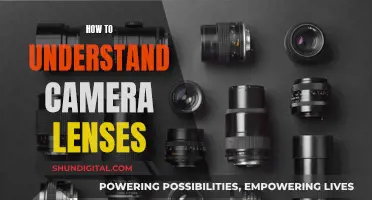
The evolution of camera lenses has been a long and complex process, with the history of lenses dating back further than that of cameras themselves. Over time, lenses have become more portable, versatile, and capable of producing higher-quality images.
The earliest concept of lenses can be traced back to the experiments of Arabic scientist Abu Ali Al-Hasan Ibn Al-Haytham (or Alhazen) between 965 and 1040 AD. He observed the distortion of objects' shapes when viewed through a glass sphere and conducted experiments with light and mirrors, paving the way for future studies on lenses and optics.
The camera obscura, a precursor to the photographic camera, utilised lenses in its design as early as 1550. By the late 17th century, portable versions of this device were being used for drawing and imaging. The invention of the camera in the early 19th century led to the development of various lens designs, with early experiments relying on simple single-element convex lenses.
The introduction of daguerreotype photography in the 1830s brought about improvements in lens technology, with lenses becoming faster and more portable. The first practical photographic process, created by Louis Daguerre, utilised an 8-hour exposure, while later improvements reduced exposure times to just a few seconds.
The evolution of lenses continued with advancements in lens design, including the introduction of achromatic lenses, variable focal lengths, and improvements in aperture control. The development of anastigmat lenses in the late 19th century marked a significant milestone, addressing issues such as rectilinear distortion and paving the way for modern lens designs.
The 20th century witnessed the rise of prominent camera and lens manufacturers like Kodak, Canon, Nikon, and Fujifilm. The introduction of photographic film by George Eastman in the late 19th century further revolutionised the industry, making photography more accessible to the general public. The first 35 mm cameras became available in the early 20th century, and the introduction of the Brownie camera in 1900 brought photography to the masses.
The advent of digital cameras in the late 20th century marked another significant shift in the camera lens landscape. Digital cameras offered wireless communication capabilities, higher resolution sensors, and more compact designs. The introduction of CMOS sensors and advancements in lens manufacturing techniques have continued to drive the evolution of camera lenses, improving image quality, reducing weight, and increasing versatility.
What You'll Learn

The first camera lens
Because the Achromat Landscape lens was quite slow, the French Society for the Encouragement of National Industry offered an international prize in 1840 for a faster one. Enter Joseph Petzval, a mathematics professor from modern-day Slovakia with no optical physics experience. With the help of several human computers from the Austro-Hungarian army, Petzval took up the challenge and designed the Petzval Portrait lens. This lens, constructed by Voigtlander, had an aperture of f/3.6, an incredible feat for its time.
Petzval's design was one of the first "pure lens designs", made through precise mathematical calculations. It had an f-number of f/3.5, a huge improvement over the contemporary standard of f/8. However, Petzval's triumph was soon marred by a nasty legal battle with Voigtlander over the rights to the lens, which he eventually won. Unfortunately, when Voigtlander moved their head office to Germany, Petzval's patents were no longer valid, and he did not profit from the majority of the lenses produced.
Chevalier's and Petzval's lenses demonstrated that additional lens elements could gather more light. They also showed that adding air-glass interfaces, rather than cementing the elements together, allowed for the correction of more aberrations, increasing image sharpness. Petzval-type lenses remained in widespread use through the 1920s and are still manufactured today.
Sigma Lenses: Blackmagic Cinema Camera Compatibility Guide
You may want to see also

The evolution of lenses from glass to plastic
The history of lenses is older than that of cameras. The earliest known experiment with lenses was conducted by Arabic scientist Abu Ali Al-Hasan Ibn Al-Haytham between 965 and 1040. He observed that the shape of an object changed when viewed through a glass sphere. This paved the way for more studies on lenses in the coming centuries.
The first practical process of photography was invented in 1839 by Louis Daguerre, and this influenced the development of camera lenses. Early lenses were made of glass, which has several advantages for optical use. It is highly transparent, resists most chemicals, does not discolour with age, and is relatively scratch-resistant. However, glass lenses are heavier and more delicate than plastic lenses, and they are difficult to tint.
The first plastic lens was marketed in 1934 by KGK Syndicate, and the first acrylic lens, the Plexiglas lens, was introduced in the same year. During World War II, plastic and acrylic lenses became widely used, and many thought glass lenses would become obsolete. Plastic lenses are made from a strong material called CR-39 and are also available in high-index lenses, which are thinner and lighter. They are more durable and less reflective than glass lenses, and they can be tinted more easily.
While glass lenses are still preferred by some for their clarity and scratch resistance, plastic lenses have become the most popular choice for lenses in recent years. Plastic lenses are lightweight, durable, and compatible with a large variety of frames. The development of lenses is ongoing, and new features are constantly being added, such as wider apertures, stabilisation, and aberration control glass.
Camera Contact Lenses: Fact or Fiction?
You may want to see also

The impact of World War II on lens development
The post-war period also saw the rise of new lens designs for use in motion pictures and television. Japan, which had been devastated by the war, invested heavily in its technological sector, including the production of high-quality cameras and lenses, forming the market base for Japanese photography companies that are still prominent today.
During World War II, the use of contact lenses by military personnel, specifically Royal Air Force aircrew, was also explored. Sealed scleral lenses were worn by RAF aircrew members to meet the required visual standards. While some pilots experienced discomfort due to heat and glare, others found that the lenses improved their vision during flights.
The war also drove the development of more lightweight and portable camera equipment, enabling camera operators to get closer to the action and capture live combat footage. Cameras such as the De Vry Standard, nicknamed 'The Lunch Box', and the Cunningham Combat Camera, made from magnesium, were used extensively by members of the British Army Film and Photographic Unit during the war.
The Evolution of Point-and-Shoot Cameras: Multiple Lenses, Many Possibilities
You may want to see also

The rise of Japanese camera lenses
Early Beginnings
The story of Japanese camera lenses began in the early 20th century, with the establishment of companies like Minolta, Nikon, and Canon. These companies would go on to play a pivotal role in the country's optical industry.
Post-World War II Era
After World War II, Japan focused on economic restructuring, investing heavily in the technological sector, including camera and lens manufacturing. This period saw the birth of high-quality cameras and lenses, forming the foundation for the country's future success in the industry.
The 1950s and 1960s
By the 1950s, Japanese camera lenses had advanced significantly, and their quality was on par with German lenses, which had been the industry leaders up until that point. This shift was largely due to the efforts of companies like Nippon Kogaku Kogyo (later known as Nikon), Konishiroku (Konica), and Canon. The Nippon Kogaku Nikkor-P Auto 10.5 cm f/2.5 lens, released in 1959, is a testament to this progress and is still reputed as one of the best portrait lenses ever made.
During this period, Japanese lenses began to break new ground, moving beyond imitations of German designs. For instance, the Canon 50mm f/0.95 lens, introduced in 1961, was the first Japanese lens to garner international attention for its superwide aperture. Additionally, Nippon Kogaku's Zoom-Nikkor Auto 43-86mm f/3.5, released in 1963, became the first popular zoom lens, despite its mediocre image quality.
The 1970s and Beyond
In the 1970s, Japanese camera lens manufacturers continued to innovate and expand their market share. Companies like Minolta, Nikon, and Canon introduced new features and improvements to their lenses, such as autofocus and image stabilization. By the 1980s, Japanese companies had gained a substantial amount of market share worldwide, and today, brands like Canon, Nikon, Fujifilm, Tamron, Sigma, and Sony are globally renowned for their lenses.
Understanding Camera Lenses: Power of Convergence and Divergence
You may want to see also

The future of camera lenses
Thinner and Lighter Lenses
One of the most significant advancements in camera lens technology is the development of ultra-thin camera lenses. Researchers from Chalmers University of Technology, Sweden, have pioneered a new technique to create artificial materials called 'metasurfaces'. These metasurfaces are composed of interacting nanoparticles that work together to control light. The resulting lens can be thousands of times thinner than traditional lenses and can also be flexible. This breakthrough has the potential to revolutionise the optical technology of tomorrow, making it possible to incorporate camera lenses into a wider range of devices.
Efficient Manufacturing
The metasurface technology developed by Chalmers University researchers also addresses manufacturing concerns. The process uses a plastic that is already commonly used in creating microstructures, and the production method employs well-established techniques and harmless chemicals. This means that metasurfaces can be manufactured using equipment already available in nano-manufacturing laboratories, streamlining the production process and making it more accessible to researchers. This increased accessibility could accelerate further innovations in the field.
Versatility in Photography
The evolution of camera lenses has already brought about a wide range of lens types, each catering to specific photography needs. From zoom lenses to prime lenses, and telephoto lenses to wide-angle lenses, photographers can choose the right tool for their specific craft, be it wildlife, sports, portraiture, or landscape photography. The introduction of metasurface lenses will further enhance this versatility, offering new effects and technological possibilities.
Integration with Portable Electronics
The ultra-thin and flexible nature of metasurface lenses makes them ideal for use in portable electronics, such as smartphones and other mobile devices. This integration will further enhance the capabilities of these devices, providing users with more advanced optical features without adding bulk.
How Does an Eclipse Affect Camera Lenses?
You may want to see also
Frequently asked questions
The earliest camera lenses were simple single-element convex lenses. These lenses were used in the first photographic experiments of Thomas Wedgwood, Nicéphore Niépce, Henry Fox Talbot, and Louis Daguerre. These lenses were found to be lacking, as they could not focus an image over a large flat film plane and suffered from other optical aberrations.
In the 19th century, lenses evolved to address the limitations of early lenses. Charles Chevalier created an achromatic lens in 1829, which reduced chromatic aberration. In 1841, Chevalier also created a double-box camera with a faster lens, reducing exposure times to 3 minutes. Other innovations during this period include the use of variable f-stops and the development of the first wide-angle lens.
In the 20th century, camera lenses continued to evolve with improvements in materials, design, and manufacturing processes. The use of rare earth and fluorite glasses with high refractive indices and low dispersion allowed for better correction of aberrations. The development of multicoated lenses reduced reflections and improved image quality. The introduction of zoom lenses and autofocus also revolutionized photography.







